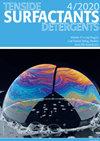拉西地平niosomal凝胶经皮给药的处方与表征
IF 1.2
4区 工程技术
Q4 CHEMISTRY, APPLIED
引用次数: 0
摘要
摘要本研究旨在通过乳泌体囊泡促进拉西地平的透皮给药。采用超声法制备拉西地平乳小体,采用Span 60作为非离子表面活性剂。分别以1:1和2:1的比例制备含有Span 60和胆固醇的配方,并增加精油的浓度。制备的纳米小体具有纳米囊泡,包封率为75.81% ~ 91.25%,体外释药率为80.61% ~ 89.81%。以粒径、包封效率和体外释药效果为指标,优选最佳处方。光学显微镜和高分辨率透射电子显微镜研究显示了一个球形的粒子体囊泡。傅里叶变换红外光谱,差示扫描量热法和x射线衍射研究证实了药物在niosomal囊泡中的完全包封。将优化后的制剂掺入凝胶基中,对其外观、pH、粘度、涂抹性、体外释药和稳定性进行评价。总的来说,结果表明,发展的乳质体拉西地平囊泡可能为该药物的现有递送系统提供了一种替代方案。本文章由计算机程序翻译,如有差异,请以英文原文为准。
Formulation and characterisation of lacidipine niosomal gel for transdermal delivery
Abstract The present study aimed to enhance the transdermal delivery of lacidipine by niosomal vesicles. Lacidipine niosomes were generated using the ultrasonic method, and Span 60 was used as a nonionic surfactant. Formulations were prepared containing Span 60 and cholesterol in 1:1 and 2:1 ratios, respectively, with essential oils added at increasing concentrations. The formulated niosomes had nano-vesicles with entrapment efficiency ranging from 75.81% to 91.25% and in-vitro drug release ranging from 80.61% to 89.81%. The optimal formulation was selected based on particle size, entrapment efficiency and in-vitro drug release. Optical microscopy and high-resolution transmission electron microscopy studies revealed a spherical shape of the niosomal vesicles. Fourier transform infrared spectroscopy, differential scanning calorimetry and X-ray diffraction studies confirmed complete encapsulation of the drug in the niosomal vesicles. The optimized formulation was also incorporated into a gel base, which was then evaluated for appearance, pH, viscosity, spreadability, in vitro drug release and stability. Overall, the results indicated that the developed niosomal lacidipine vesicles may provide an alternative to existing delivery systems for this drug.
求助全文
通过发布文献求助,成功后即可免费获取论文全文。
去求助
来源期刊

Tenside Surfactants Detergents
工程技术-工程:化工
CiteScore
1.90
自引率
10.00%
发文量
57
审稿时长
3.8 months
期刊介绍:
Tenside Surfactants Detergents offers the most recent results of research and development in all fields of surfactant chemistry, such as: synthesis, analysis, physicochemical properties, new types of surfactants, progress in production processes, application-related problems and environmental behavior. Since 1964 Tenside Surfactants Detergents offers strictly peer-reviewed, high-quality articles by renowned specialists around the world.
 求助内容:
求助内容: 应助结果提醒方式:
应助结果提醒方式:


